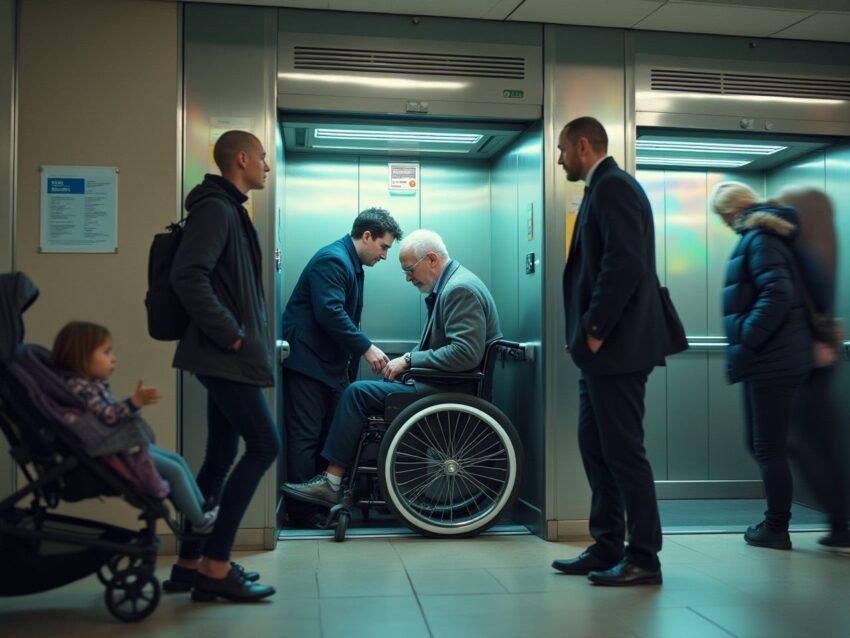UK Railway Stations facing Accessibility Issues, A Growing Concern for Travelers – All You Need to Know Now
Rising lift failures at UK railway stations impact disabled travelers, families, and commuters. Urgent action needed to improve accessibility and safety.
Train travel is one of the most enjoyable and stress-free ways to travel, but for many people, including disabled passengers, parents with young children and people carrying bulky luggage, a crucial aspect of UK railway stations are lifts which can be a thing of terror. Recent stories have highlighted an alarming number of instances where passengers become trapped in lifts at UK stations and remain stuck for prolonged periods, preventing those who are disabled, older, ill or carrying luggage from travelling and raising questions of safety.
Between 2022 and 2024, the number of people trapped inside railway station lifts for more than 75 minutes doubled, according to the the Office of Rail and Road (ORR). There were 125 reported entrapments in the year that ended in March 2024, compared with 67 the previous year. For the many travelers who reply on lifts to get through stations safely, these numbers underscore what one could argue is a dire problem with lift maintenance and dependability.
The Role of Uplifts for At-Risk Travelers
Lifts are not a luxury for passengers with disabilities or other mobility limitations, but a necessity for safe travel. Likewise, travellers with strollers or large suitcases depend on elevators so they don’t have to carry them up and down stairs or escalators. But, alas, when the lifts stop working, we get a situation that is at best very uncomfortable and at worst quite hazardous.
Pressure group transport for all, which supports disabled travellers, has called Network Rail to account for not making sure lifts are kept in good working order and has spoken about lift entrapment being a terrifying experience for disabled passengers. A lot of these passengers are going to really struggle if they’re left in a lift without prompt power and they really have a problem if they’re then let down when they need support the most.
Response Time and Lift Failures increasing
Response times continue to get worse. In average it now takes 51 minutes to free stranded passengers, far more than the 44 minutes per average in 2022/23. The fact that those stranded must wait so long for help to materialize only makes the misery worse.
The incidence of lift failures has also increased dramatically. There were 9,587 reports of lift faults in the 12 months to March 2024, up from 8,233 the previous year. This trend has caused a significant increase in the number of cases of passengers being immobilized in their path and has clearly indicated the need for improvement in the up-keeping and reliability of such vital components.
The Family Vacation Nightmare
A spokesperson from the Campaign for Family-Friendly Trains said travelling alone with children was already a nerve-wracking experience for parents, particularly mothers. It’s even more of a problem if the lift breaks down while a parent is with an infant or a toddler. Parents sometimes need to navigate a pushchair down a staircase, or hope there is a kind stranger to help them lug it up to street level, which can be both dangerous and exhausting.
This additional pressure underscore the importance for stations to support the insistence on keeping both a working lift and a rapid response contingency for parents in such difficult predicaments. Lift mishaps shouldn’t put families in danger while out on what is supposed to be a fun trip.
A Call for Urgent Action
This continuous increase in the accident of the lift demands attention from the stakeholders involved in station safety. More than 60 per cent of all lift failures are due to age-related wear and tear; so it is quite possible that some lifts are long past their use by date. Collectively they are an integral part of the lives of thousands of people who depend on them for their daily transport.
Network Rail has pledged to improve the service through better maintenance and the installation of extra lifts at stations – 59 new lifts in the year to March 2024. In a separate incident, a woman and her flaming wheelchair were one of the most recent examples of why more must be done to improve access to rail services in the UK and to ensure that responsibility is taken for such incidents.
Looking Forward: A Better Experience for Travelers
Accessibility should be a priority as the UK rail network develops. Rising lift failures and entrapments serve as reminders that more maintenance, faster response times and greater investment are necessary to ensure that lifts work the way they are meant to. Failing to sort out these issues will mean people will lose trust in the railways and it will make the journeys of everyone using the rail network less safe and less convenient.
The post UK Railway Stations facing Accessibility Issues, A Growing Concern for Travelers – All You Need to Know Now appeared first on Travel and Tour World


